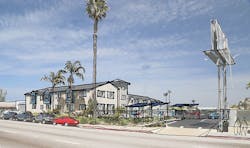Designing for homeless facilities: Critical spaces to consider
The headlines are undeniable: Half a million people across the U.S. are homeless. Of that, 193,000 people have no access to nightly shelter and live in tents, cars, or on the streets. The City of San Diego is home to the fourth largest homeless population in the U.S. As designers based in this city, we find ourselves constantly asking, “How can we help?”
A year ago, the City of San Diego approached Gensler with an opportunity to work on the refresh of an existing homeless day center. Our designers were eager to participate, and since then we have had the honor of working on the programming and design of several more projects for the homeless including: a day center, transitional housing facility, and a bridge shelter. Over the span of these projects we have come to learn what some of the most critical spaces in homeless facilities are and why they are so essential.
Homeless Day Center – Design for community room with storage cubbies. Image © Gensler.
Mail Delivery
As we toured our first project, a Homeless Day Center, we quickly realized that one of the center’s most critical functions is secure mail delivery. People don’t typically think that mail can be a top necessity for the homeless—you might think of food and shelter, but not the U.S. Postal Service. Yet, at each site visit, we saw a line of people waiting to receive their mail. The mail consists mostly of food stamps, Medicaid benefits, disability benefits, supplemental security income, and LifeLine phones—benefits designed to help struggling low-income Americans.
Storage Space
Each type of facility we visited and worked on had a need for secure storage. For instance, the day center includes cubbies for charging phones and storing small items in the community room, day storage for larger items, a small outdoor building where people can reserve storage boxes for longer lengths of time, and an area for storing shopping carts at the back of the property. The City is also discussing the possiblity of purchasing an existing warehouse where the homeless can safely store their belongings. Secure storage is extremely important because people need to eat, rest, clean up, access services, interview, go to work, attend school, and get treatment without worrying about losing their property.
Homeless Day Center – Design of new shade canopy and privacy screen. Image © Gensler.
Personal Hygiene Space
All of the spaces we worked on included spaces for personal hygiene, ranging from simple outdoor sinks for quick face/hand/pet washes to shower and laundry facilities. One of the day center’s more pressing needs was the addition of a women’s shower room, since the facility was built at a time when there were fewer homeless women than men.
Safe Space
Security is a primary need for all of the projects we have been involved with. Security is geared towards keeping those who don’t belong or cause trouble out of the facilities and clearing up any issues that may arise inside. The day center offers a gated perimiter so people who spend their nights on the streets can rest safely during the day. The Super 8 Hotel that is being converted into a transitional housing facility will house adults who have had two quality of life arrests in the past six months and two drug offenses since the passage of Proposition 47. The program supporting this facility is designed to help individuals get out of the revolving door of the criminal justice system and back into society. The facility will provide housing, a case manager, housing navigator, and food for participants. The space will also have a large rolling gate for vehicle access and is staffed by an on-site manager.
The large tent structures—known as Bridge Shelters, because they are meant to connect a formerly homeless individual to permanent supportive housing—have 24-hour security, with security staff accounting for almost half of all staff at these shelters. The safety measures at these facilities incorporate physical barriers such as gates and doors, but also need to create office spaces for security staff to work and rest.
Plan showing the layout of a Bridge Shelter. Image © Gensler.
Homelessness is usually not a choice. It affects all of us—every gender, every age, in every city. We hope these insights will provide some understanding of the variety of shelters that are available, and will introduce some of the most essential spaces. By gaining knowledge of these critical spaces, we can include them to not only help with homeless facilities’ basic needs, but to create spaces that can be a refuge, a space to revive, and a place to provide safety and dignity for the homeless population.
About the Author
Gensler
A global design firm with more than 5,000 practitioners networked across five continents, Gensler features insights and opinions of architects and designers on how design innovation makes cities more livable, work smarter, and leisure more engaging. Our contributors write about projects of every scale, from refreshing a retailer’s brand to planning a new urban district, all the while explaining how great design can optimize business performance and human potential. For more thought leadership and blog content, visit our Research & Insight page. Follow us on Facebook, LinkedIn, and Twitter.
